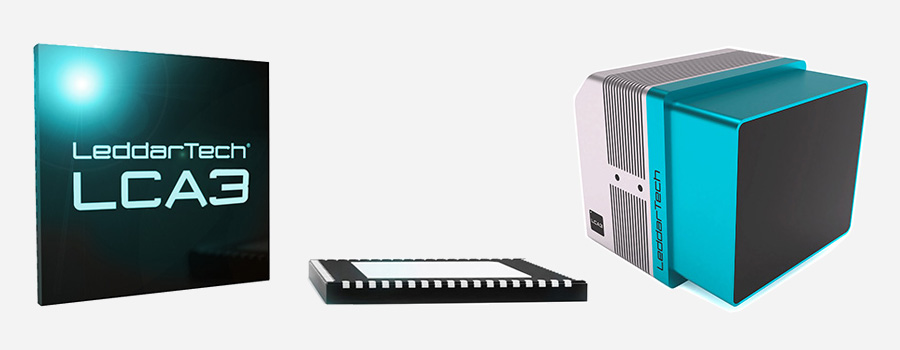- Using Word and Excel files resulted in limitations of collaborative editing, versioning friction, and difficult traceability
- Development challenges in the innovation of high-tech light detection and ranging (LiDAR) sensing systems
- Difficult time tracking changes in specifications and tracing test cases back to requirements and vice versa
About LeddarTech
LeddarTech is a leader in environmental sensing solutions for autonomous vehicles and advanced driver assistance systems. Founded in 2007, the Canadian company provides comprehensive end-to-end environmental sensing solutions to innovators at the cutting edge of automotive and mobility development.
LeddarTech’s products include sensor fusion and perception chips, as well as the components necessary for building LiDAR sensors. Using the company’s technology, auto innovators (OEMs, Tier 1 and 2 suppliers, and system integrators) can develop automotive-grade, solid-state LiDARs to drive the future of digital mobility. LeddarTech’s technology is actively used in autonomous shuttles, trucks, buses, delivery vehicles, robotaxis, and smart city and factory applications.
To overcome development challenges in the innovation of high-tech LiDAR sensing systems, LeddarTech started the search for an integrated Application Lifecycle Management (ALM) solution in 2017. By the end of that year, the company made the decision to purchase Codebeamer, and has been using the platform ever since. This case study summarizes their pain points, experiences evaluating ALM platforms, and the benefits they were able to realize through implementing Codebeamer.
Versioning friction and problems of collaboration
At the outset, LeddarTech’s development teams relied on the old-fashioned toolset that will seem familiar to auto innovators worldwide: rRequirements were entered in Microsoft Word files that were kept track of in Excel sheets. These files were exchanged back and forth via email within and across teams and placed in shared folders for collaboration.
When changes were made on a document, its revision ID would be manually updated—until of course it wasn’t. Inadvertent mistakes are inevitable in a tool environment that opens up ample opportunity for manual error. Like in most cases, this makeshift tooling resulted in discord and made it very difficult to establish traceability across the lifecycle of product delivery. At one point, there was even a problem of change tracking at one of LeddarTech’s suppliers that was pointed out during an audit.
The company’s development teams had a hard time tracking changes in specifications and tracing test cases back to requirements and vice versa. With limited traceability, it was difficult to manage bugs and to dispatch their corrections, or to have any real visibility into software development activities. Finally, this legacy tooling made the centralization of documents related to projects highly problematic, hindering alignment across the lifecycle.
Van Hue Truong, Senior QA Specialist, LeddarTech
Van is a seasoned Quality Engineer with over 20 years of experience. Prior to joining LeddarTech, she has supported the Quality Assurance (QA) processes of various digital health technology companies. Having joined LeddarTech in 2018, she didn’t participate in the ALM selection process, but was part of its rollout. Van uses Codebeamer actively to oversee LeddarTech’s product QA activities.
Van provided input for this case study to help us understand the problems this auto tech innovator was facing, and how transitioning to integrated ALM helped solved those problems.

Recognizing that their age-old tooling was ineffectual and unproductive in the face of future development challenges that involved ISO 26262 compliance, LeddarTech’s development team began scanning the market for integrated Application Lifecycle Management tooling.

Evaluation: Laser focus on ISO 26262-ready ALM
In 2017, LeddarTech started the search for an ALM platform that would enable them to:
- Trace the history of changes (what was changed, by whom, and when) on all their artifacts
- Baseline different versions
- Establish a shared central platform for requirements and specifications across different projects
- Produce a Traceability Matrix easily and with information that is always up to date
- Analyze test coverage, and manage test cases and test execution in conjunction with the appropriate requirements
- Support the company’s Agile transition
- Manage releases and links between user stories, tasks, bugs, and releases
In addition to these fundamental requirements, LeddarTech considered ease of use, the quality of documentation, and ISO 26262-certification. They were looking for a web-based tool for easy collaboration and wanted a shared Wiki space, Sscrum, and Kanban support, as well as configuration and document management capabilities in their future ALM platform.
Initially, a number of tools were considered, including Atlassian Jira, Helix ALM, TracPlus, Jama Connect, Siemens Polarion, IBM Rational DOORS, and TechExcel. After a thorough evaluation of vendor offerings, Codebeamer was eventually selected and rolled out at LeddarTech’s engineering department of 80 team members.
Combining Agile and ALM in ISO 26262-compliant development
Ever since the platform was implemented, LeddarTech’s product teams have been using Codebeamer to manage the entire product development lifecycle end- to- end. LeddarTech made the transition to Agile shortly after the platform was implemented. While this was not a strategic factor when evaluating ALM tools, the team was happy to see that Codebeamer was able to assist their transition to iterative and incremental development:
Today, LeddarTech’s development teams rely heavily on some of the core capabilities of Codebeamer, including:
- Requirements management
- Test Management
- Review Hub
- Bug tracking
- Sprint planning
- Change management
- Wiki pages for sharing project data
- Test coverage analysis
- Traceability Matrix
Approval processes have especially benefited from the switch to integrated ALM. Before making the transition to Application Lifecycle Management, LeddarTech’s review processes were fully manual. Documents were distributed via email to multiple reviewers, with an appointed team member responsible for managing changes on the document. Once the reviewing was done, the document would be sent to the approvers, who would simply approve or reject documents by replying via email.
Using Codebeamer’s Review Hub, LeddarTech was able to streamline that process and achieve complete transparency around the details of each review (who reviewed what, when, with visibility into any additional comments to reviewed items).
Integrations weren’t a major concern at LeddarTech—though one of the teams currently working on a pilot project to import automated test results was happy to see that Codebeamer’s REST API was easy to work with. MS Word and Excel documents are still used to exchange product specifications with suppliers, but requirements are baselined in Codebeamer for adequate control and visibility on changes.
Benefits of ALM in digital mobility innovation
After making the switch to integrated Application Lifecycle Management with Codebeamer, LeddarTech’s software teams enjoy greater clarity in their development processes.
Collaboration is easier as team members now work on shared trackers, and all lifecycle data is centralized. Workflows, task, and project management features help LeddarTech’s teams monitor the status of items at all times, enabling better visibility into project progress. Custom dashboards are used to keep track of issues and project progress. Each LeddarTech team has its own custom- configured dashboard to monitor and share information related to their specific development or QA activities.
By enabling teams to trace tasks, user stories, tests, and other artifacts upstream and downstream, Codebeamer provides traceability across the entire lifecycle, which is crucial for ISO 26262-compliant product development.